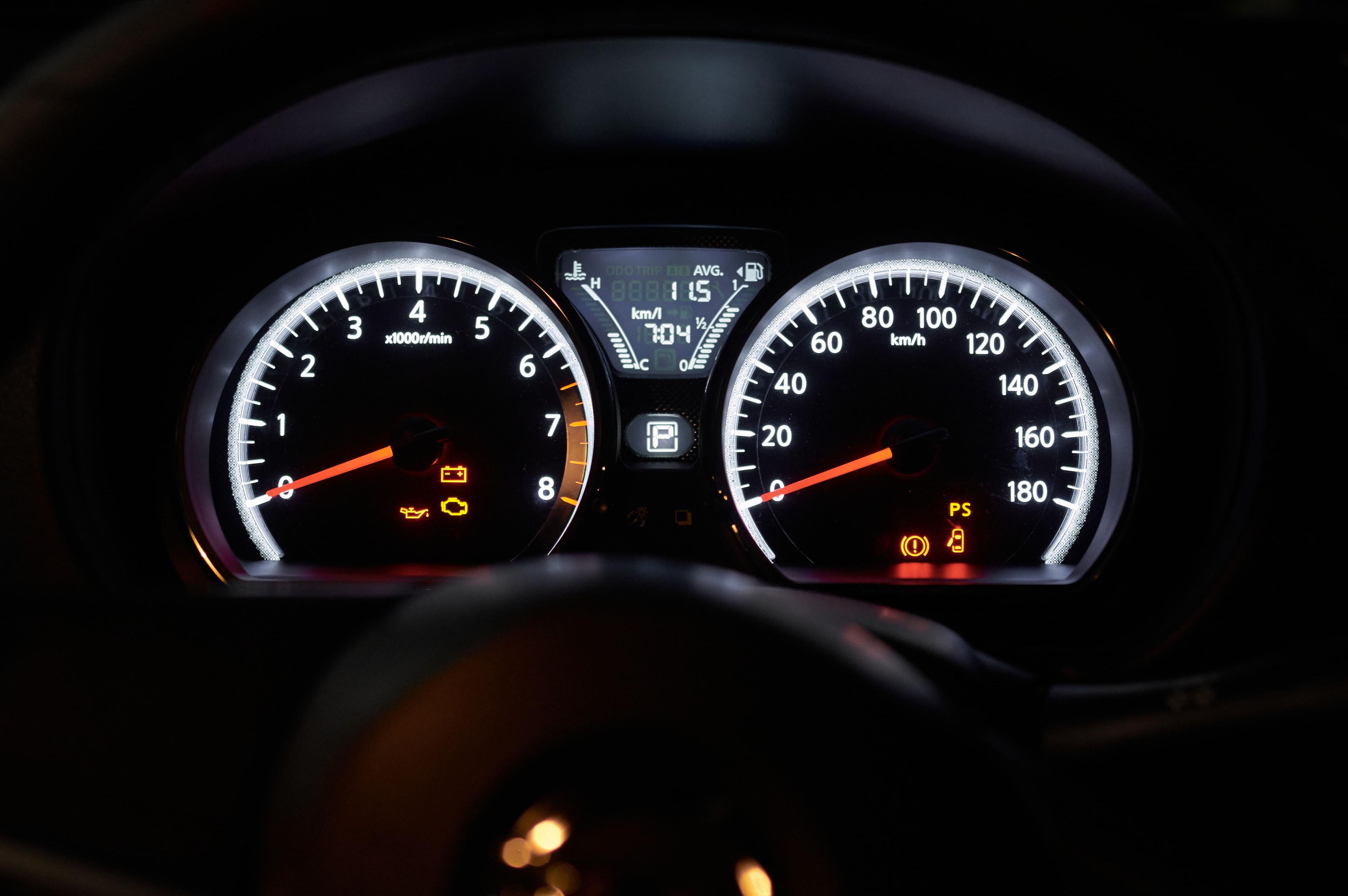Demystifying Dashboard Warning Lights: A Comprehensive Guide
Published on Jan 23, 2024 • 10 min read

When it comes to the language of your car, few things speak louder than the lights on your dashboard. These warning lights are like the vehicle’s own Morse code, signaling potential issues that demand attention. In this comprehensive guide, we’ll unravel the meanings behind the most common dashboard warning lights, empowering you to decipher their messages and take informed action.
Check Engine Light (CEL):
- Meaning: A diagnostic code indicating a problem with the engine or emission control system.
- What to do: Schedule a diagnostic check to pinpoint the issue, ranging from a loose gas cap to more serious engine concerns.
Oil Pressure Warning Light:
- Meaning: Illuminates when oil pressure is dangerously low, risking engine damage.
- What to do: Immediately check the oil level and top it up if low. For persistent issues, consult a professional for a comprehensive diagnosis.
Coolant Temperature Warning Light:
- Meaning: Indicates an engine running hotter than normal.
- What to do: Safely pull over, let the engine cool, and inspect coolant levels. Persistent issues may signal a coolant leak or a problem with the cooling system.
Brake System Warning Light:
- Meaning: Signals a potential issue with the brake system.
- What to do: Check brake fluid levels and inspect for leaks. If issues persist, seek professional inspection and repair.
Traction Control System (TCS) or ESP Warning Light:
- Meaning: Alerts to a problem with the traction or stability system.
- What to do: Ensure the system is not accidentally turned off. Persistent issues may require professional attention to sensor problems.
Fog Light (Front):
- Meaning: Indicates that the front fog lights are turned on.
- Explanation: Front fog lights improve visibility in foggy conditions by illuminating the road close to the vehicle.
- What to do: No specific action is required; it’s an informational light.
Power Steering Warning Light:
- Meaning: Signals a problem with the power steering system.
- Explanation: This light may indicate low power steering fluid, a failing power steering pump, or an issue with the steering gear.
- What to do: Check power steering fluid levels. If low, top up; if the light persists, seek professional assistance.
Fog Light (Rear):
- Meaning: Indicates that the rear fog lights are turned on.
- Explanation: Rear fog lights enhance visibility for drivers behind you in foggy conditions.
- What to do: No specific action is required; it’s an informational light.
Washer Fluid Low:
- Meaning: Indicates that the windshield washer fluid level is low.
- Explanation: This light reminds you to refill the washer fluid reservoir to ensure a clear view through the windshield.
- What to do: Refill the washer fluid as soon as possible.
Brake Pad Warning:
- Meaning: Alerts to worn brake pads.
- Explanation: When brake pads wear down, sensors trigger this warning.
- What to do: Replace the brake pads promptly to maintain effective braking performance.
Cruise Control On:
- Meaning: Signals that the cruise control system is active.
- Explanation: Cruise control maintains a set speed without continuous driver input.
- What to do: No specific action is required; it’s an informational light.
Direction Indicators:
- Meaning: Indicates that the vehicle’s turn signals are activated.
- Explanation: The blinking arrows show the direction in which the vehicle is turning.
- What to do: No specific action is required; it’s an informational light.
Rain and Light Sensor:
- Meaning: Indicates that the rain and light sensor is active.
- Explanation: The sensor automatically adjusts wiper speed and headlights based on external conditions.
- What to do: No specific action is required; it’s an informational light.
Winter Mode:
- Meaning: Signals the activation of winter driving mode.
- Explanation: Winter mode adjusts the vehicle’s performance to enhance traction in slippery conditions.
- What to do: No specific action is required; it’s an informational light.
Information Indicator:
- Meaning: Alerts to non-urgent information or messages.
- Explanation: This light may accompany messages displayed on the car’s information display.
- What to do: Check the information display for additional details or messages.
Glow Plug/Diesel Pre-heat Warning:
- Meaning Indicates that the glow plugs are pre-heating in a diesel engine.
- Explanation: Glow plugs warm the combustion chamber for easier starting in cold conditions.
- What to do: Wait for the light to go out before starting the engine.
Frost Warning:
- Meaning Indicates that external temperatures are near freezing.
- Explanation: Warns of potential icy conditions on the road.
- What to do: Drive with caution in cold and icy conditions.
Ignition Switch Warning:
- Meaning: Alerts to an issue with the ignition switch.
- Explanation: Indicates a potential problem with the ignition switch or key.
- What to do: Check the key and ignition switch; if issues persist, seek professional help.
Key Not in Vehicle:
- Meaning: Alerts that the key is not detected inside the vehicle.
- Explanation: Reminds the driver to ensure the key is inside the car before driving.
- What to do: Ensure the key is inside the vehicle before driving.
Key Fob Battery Low:
- Meaning: Indicates a low battery in the key fob.
- Explanation: The battery in the key fob may need replacement soon.
- What to do: Replace the key fob battery as soon as possible.
Distance Warning:
- Meaning: Alerts to the proximity of the vehicle ahead.
- Explanation: Distance warning systems use sensors to gauge the distance to the vehicle in front.
- What to do: Maintain a safe following distance; no specific action required.
Press Clutch Pedal:
- Meaning: Reminds the driver to engage the clutch before starting the vehicle.
- Explanation: Manual transmission cars require the clutch to be engaged for starting.
- What to do: Press the clutch pedal when starting the engine in a manual transmission vehicle.
Press Brake Pedal:
- Meaning: Reminds the driver to depress the brake pedal before starting the vehicle.
- Explanation: Some vehicles require the brake pedal to be pressed for engine ignition.
- What to do: Press the brake pedal when starting the engine.
Steering Lock Warning:
- Meaning: Indicates that the steering wheel is locked.
- Explanation: The steering wheel may lock when the ignition is off to deter theft.
- What to do: Insert the key and turn the ignition to unlock the steering wheel.
Main Beam Headlights:
- Meaning: Indicates that the vehicle’s high beams are activated.
- Explanation: High beams provide maximum illumination but should be used judiciously to avoid blinding other drivers.
- What to do: Dim the headlights when approaching other vehicles.
Tire Pressure Low:
- Meaning: Alerts to low tire pressure in one or more tires.
- Explanation: Low tire pressure can affect vehicle handling and fuel efficiency.
- What to do: Check tire pressure, adjust the tires; if the issue persists, inspect for punctures or leaks.
Sidelight Information:
- Meaning: Indicates the status of the vehicle’s sidelights.
- Explanation: Sidelights, also known as parking lights, enhance vehicle visibility in low-light conditions.
- What to do: No specific action is required; it’s an informational light.
Exterior Light Fault:
- Meaning: Signals a fault in the external lighting system.
- Explanation: There may be an issue with a headlight, taillight, or another exterior light.
- What to do: Inspect the exterior lights for faults or seek professional assistance.
Brake Lights Warning:
- Meaning: Alerts to a problem with the brake lights.
- Explanation: One or more brake lights may be malfunctioning.
- What to do: Check brake lights; if faulty, replace bulbs or seek professional help.
Diesel Particulate Filter Warning:
- Meaning: Indicates an issue with the diesel particulate filter.
- Explanation: The filter traps and reduces emissions, and a warning light may indicate a blockage.
- What to do: Follow manufacturer recommendations for filter maintenance or seek professional help.
Trailer Tow Hitch Warning:
- Meaning: Alerts to an issue with the trailer tow hitch.
- Explanation: There may be a problem with the trailer connection or wiring.
- What to do: Inspect the trailer hitch and connections for issues.
Air Suspension Warning:
- Meaning: Signals a problem with the air suspension system.
- Explanation: Air suspension systems provide a smoother ride, and a warning light may indicate a leak or malfunction.
- What to do: Seek professional assistance to diagnose and repair the air suspension.
Lane Departure Warning:
- Meaning: Indicates that the vehicle is unintentionally leaving its lane.
- Explanation: Lane departure warning systems use sensors to detect lane markings and alert the driver if the vehicle drifts.
- What to do: Correct the vehicle’s position within the lane.
Catalytic Converter Warning:
- Meaning: Alerts to a potential issue with the catalytic converter.
- Explanation: The catalytic converter reduces emissions, and a warning light may indicate a problem.
- What to do: Seek professional assistance for diagnosis and repair.
Seat Belt Not On:
- Meaning: Reminds the driver or passenger to fasten their seat belt.
- Explanation: Seat belts are crucial for occupant safety in the event of a collision.
- What to do: Fasten the seat belt for safety.
Parking Brake Light:
- Meaning: Indicates that the parking brake is engaged.
- Explanation: The parking brake, when engaged, prevents the vehicle from moving.
- What to do: Release the parking brake before driving.
Battery/Alternator Warning:
- Meaning: Signals a problem with the battery or alternator.
- Explanation: Low battery voltage or alternator issues can affect electrical systems.
- What to do: Check the battery terminals; if issues persist, seek professional assistance.
- Parking Assist:
- Meaning: Indicates that the parking assist system is active.
- Explanation: Parking assist uses sensors to help the driver park the vehicle.
- What to do: Follow the system prompts for parking assistance.
Service Required:
- Meaning: Indicates that the vehicle is due for routine maintenance or a service appointment.
- Explanation: Regular servicing is essential for the health and longevity of the vehicle.
- What to do: Schedule a service appointment as recommended by the manufacturer.
Adaptive Lighting:
- Meaning: Signals that the adaptive lighting system is active.
- Explanation: Adaptive lighting adjusts the direction and range of the headlights based on driving conditions.
- What to do: No specific action is required; it’s an informational light.
Headlight Range Control:
- Meaning: Indicates that the headlight range control system is active.
- Explanation: Headlight range control adjusts the height and range of the headlights based on vehicle load.
- What to do: No specific action is required; it’s an informational light.
Rear Spoiler Warning:
- Meaning: Alerts to a problem with the rear spoiler.
- Explanation: There may be a malfunction or issue with the retractable rear spoiler.
- What to do: Inspect the rear spoiler for issues or seek professional assistance.
Convertible Roof Warning:
- Meaning: Signals a problem with the convertible roof system.
- Explanation: There may be an issue with the roof mechanism or sensors.
- What to do: Check for obstructions and proper closure; if issues persist, seek professional help.
Airbag Warning:
- Meaning: Indicates a problem with the airbag system.
- Explanation: The airbag system may not deploy properly in the event of a collision.
- What to do: Seek immediate professional assistance to diagnose and repair the airbag system.
Handbrake Warning:
- Meaning: Indicates that the handbrake is engaged.
- Explanation: The handbrake prevents the vehicle from moving when parked.
- What to do: Release the handbrake before driving.
Water in Filter:
- Meaning: Alerts to the presence of water in the fuel filter.
- Explanation: Water in the fuel can cause engine damage.
- What to do: Drain the water from the fuel filter as per the manufacturer’s instructions.
Airbag Deactivated:
- Meaning: Indicates that the airbag system for a specific seat is deactivated.
- Explanation: The airbag is deactivated to accommodate a child seat or due to a malfunction.
- What to do: If intentional, no action is required; if unintentional, seek professional assistance.
Fault Problem:
- Meaning: Signals a general fault or problem with the vehicle.
- Explanation: There may be a malfunction in a system not specifically indicated by another warning light.
- What to do: Seek professional assistance to diagnose and address the fault.
Dipped Beam Headlights:
- Meaning: Indicates that the vehicle’s low beams are activated.
- Explanation: Low beams are used for normal driving conditions to avoid blinding other drivers.
- What to do: No specific action is required; it’s an informational light.
Dirty Air Filter:
- Meaning: Alerts to a dirty or clogged engine air filter.
- Explanation: A dirty air filter can reduce engine performance and fuel efficiency.
- What to do: Replace the air filter as recommended by the manufacturer.
Eco Driving Indicator:
- Meaning: Indicates that driving conditions are optimal for fuel efficiency.
- Explanation: Encourages fuel-efficient driving habits.
- What to do: Adjust driving habits to maximize fuel efficiency.
Hill Descent Control:
- Meaning: Indicates that hill descent control is active.
- Explanation: Hill descent control helps control vehicle speed when descending steep slopes.
- What to do: No specific action is required; it’s an informational light.
ABS Warning (Anti-lock Braking System):
- Meaning: This warning light indicates an issue with the Anti-lock Braking System, which helps prevent wheel lock-up during heavy braking.
- Explanation: The ABS system prevents skidding by modulating brake pressure during sudden stops. A malfunction may compromise your ability to maintain control during emergency braking.
- What to do: Seek professional assistance immediately, as it may affect the car’s braking performance.
Fuel Filter Warning:
- Meaning: This warning signals that the fuel filter is clogged or needs replacement.
- Explanation: The fuel filter ensures clean fuel reaches the engine. A clogged filter can reduce fuel flow, affecting engine performance and potentially causing damage.
- What to do: Schedule maintenance to replace the fuel filter as soon as possible. A clogged filter can affect engine performance.
Door Open:
- Meaning: One of the doors is not fully closed.
- Explanation: Modern cars have sensors to detect open doors. If a door is ajar, it could lead to safety hazards, such as doors unexpectedly opening during driving.
- What to do: Check all doors and the trunk to ensure they are properly closed. If the warning persists, there may be an issue with the door sensor.
Bonnet Open:
- Meaning: The hood (bonnet) of the car is not securely closed.
- Explanation: The bonnet open warning indicates that the hood is not properly latched. Driving with the hood open can lead to severe damage and is a safety hazard.
- What to do: Pull over safely, check and secure the hood latch. Driving with the bonnet open is dangerous and may result in serious damage.
Low Fuel:
- Meaning: The fuel level is critically low.
- Explanation: This warning indicates that the remaining fuel is very low. Ignoring this warning may cause the engine to stall.
- What to do: Refuel as soon as possible to avoid running out of gas. Ignoring this warning may cause the engine to stall.
Automatic Gearbox Warning:
- Meaning: There’s a malfunction in the automatic transmission.
- Explanation: The automatic gearbox warning suggests an issue with the transmission system, which could impact the car’s performance and safety.
- What to do: Consult the vehicle’s manual. If the problem persists, seek professional help immediately, as driving with transmission issues can cause severe damage.
Speed Limiter:
- Meaning: The speed limiter is engaged, restricting the vehicle’s speed.
- Explanation: Some vehicles have a speed limiter that caps the maximum speed. This warning indicates that the limiter is active.
- What to do: Adjust the speed limiter settings according to your preferences. Refer to the owner’s manual for instructions.
Suspension Dampers:
- Meaning: There’s an issue with the suspension dampers or shock absorbers.
- Explanation: Suspension dampers contribute to ride comfort and stability. A warning suggests a potential problem with these components.
- What to do: Schedule an inspection with a qualified mechanic. Faulty dampers can affect ride comfort and handling.
Oil Pressure Low:
- Meaning: The engine oil pressure is below the recommended level.
- Explanation: Proper oil pressure is crucial for lubricating engine components. Low oil pressure can lead to engine damage.
- What to do: Immediately stop the vehicle and check your oil level. If it’s low, top it up. Continued driving with low oil pressure can cause severe engine damage.
Windscreen Defrost:
- Meaning: The windscreen defrosting system is active.
- Explanation: This is usually an informational light. The system is working to clear frost or condensation from the windshield.
- What to do: Ensure that the defrosting system is working correctly, especially in cold weather.
Boot Open:
- Meaning: The trunk (boot) is not securely closed.
- Explanation: The warning indicates that the trunk is not fully closed, which can lead to safety issues.
- What to do: Pull over safely, check and secure the trunk. Driving with the boot open can be hazardous.
Stability Control Off:
- Meaning: The electronic stability control system is turned off.
- Explanation: Stability control enhances vehicle stability during cornering. The warning indicates the system is deactivated.
- What to do: Consider turning it back on, especially during adverse driving conditions. If it turns off automatically, there may be a system malfunction.
Rain Sensor:
- Meaning: The automatic rain-sensing wipers are active.
- Explanation: This light indicates that the rain-sensing wipers are in use, adjusting their speed based on the amount of rainfall.
- What to do: Ensure that the wipers are functioning properly. Adjust the sensitivity settings if needed.
Engine/Emissions Warning:
- Meaning: There’s a problem with the engine or emissions system.
- Explanation: The warning suggests a malfunction in the engine or emissions control system, which can impact performance and contribute to environmental issues.
- What to do: Schedule a diagnostic check as soon as possible. Continuing to drive with this warning may lead to more serious issues.
Rear Window Defrost:
- Meaning: The rear window defrosting system is active.
- Explanation: Similar to the front defrost, this light indicates that the rear window defrosting system is in operation.
- What to do: Ensure that the rear window is clearing properly, especially in cold weather.
Auto Windscreen Wiping:
- Meaning: The automatic windshield wipers are active.
- Explanation: This light indicates that the automatic wipers are adjusting their speed based on the amount of rainfall.
- What to do: Check that the wipers are functioning properly. Adjust the sensitivity settings if needed.
Your car’s dashboard is a symphony of lights, each telling a story. Understanding these signals is not just about preventing breakdowns but ensuring the safety and longevity of your vehicle. Consult your vehicle’s manual for specific details, and remember, prompt action in response to warning lights is your best ally on the road.
Related Articles

Navigating the Vehicle Marketplace: Why Autostoday?
Online platforms have revolutionized the way we buy, sell, and trade cars.
Nov 28, 2024 • 3 min read

Make Your Best Buy Ever
We've curated the absolute best of online buying tips.
Dec 4, 2023 • 2 min read

A Holiday Guide to Buying a Used Vehicle and Saving Big
The end of the year marks a significant surge in car purchases
Feb 13, 2025 • 5 min read

Unlock January’s Best Auto Deals
January: Ideal time to buy a car online - price benefits and great deals.
Jan 9, 2025 • 3 min read